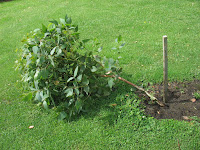December weather has been even more amazing than November’s, with unbelievable variations – from freezing cold and rainy to warm, summery days; more rain and ending on the final day of the month with 40 degrees and one of those hot northerly winds which, as I write, is managing to rip branches off any tree it can get hold of.
 |
| The Willow that the hard-working grandsons had just finished pruning got a bit more unexpected pruning from the wind. |
Even more of a challenge for this particular gardener has been the advent of a ‘Bad Back’! Always hard to live with for anyone, a bad back for a gardener is doubly frustrating. The first two weeks of December were spent hobbling around almost unable to walk - much less bend - but after some careful and gentle treatment from an Osteopath, things slowly improved. Bending is OUT, as well as any sudden movement or turn. However, once I became relatively mobile again, husband Geoff and I developed a few special tools to help with some of the easier gardening tasks and enabled me to feel a little less useless.
 |
| Behold! The Long Handled Spoon and the Magic Pick-up Stick! |
Helping hands and strong muscles!
There has also been a very helpful visit from two big grandsons who offered to drive up from Melbourne and get some heavy jobs done for us. They happily (and sooo easily!) moved some very big stones to edge the driveway, a job which was far too heavy for either of us to attempt. They also trimmed the Willow tree and disposed of the prunings and generally made themselves VERY useful with weeding, lifting, carting compost, sawing branches, etc. etc.
 |
| Big rocks need big muscles! |
 |
| Sadly, these muscles were too strong for my spade handle! |
"Magic Sunflower Circle House"
Then came the fun project – a Sunflower House. I’d seen it on a TV program and it sounded like a great idea for when smaller grandchildren visit.
We marked out quite a large circle, the boys dug a trench around the perimeter and disposed of the grass. Then they filled it with compost and planted the sunflower seeds. I was very happy to email them one week later and report that almost all of the seeds had come up and were looking extremely healthy. Next comes deciding how many of these many plants we need to thin out. Too close and they won’t grow big and strong, too far apart and we won’t get the effect we’re after of a secret hiding place for small children. It’s going to be an interesting experiment.
 |
| Within a week, almost every seed came up. Deciding how much to thin them out is the next decision. |
After all the rain in spring, the sunshine and heat that arrived in the first week of December produced enormous growth everywhere - unrestrained, undisciplined, wild growth! The asparagus shot up from normal size to more than a metre overnight; the Silver Beet grew and grew and went to seed in a week; the tomatoes tripled their size in a week and suddenly produced baby tomatoes; and we have been inundated with broad beans from neighbours who just can’t eat all their produce and can’t give it away fast enough. Geoff is complaining that mowing the grass is just like painting the Sydney Harbour Bridge – he’s no sooner finished than he has to start again. And to think that a little more than a year ago we were complaining about a drought!
... and even more rain.
A day of sunshine and 34 degree heat around the 5th or 6th was followed by ominous black clouds that brought a hail storm and more days of rain. A farm dam on the edge of town broke its banks and flowed out over roads and down the hillside, losing gallons and gallons of precious water. Again, our block became soggy and, to my grave concern, one of my small Eucalypts was left in a puddle of water. A day or so later my fears were realised and, after experiencing some strong winds, when I went out to check I found it flat on the ground.
 |
| Not looking good. |
 |
| Worst fears realised. |
Grapes
It seems the wet weather isn’t appreciated by Geoff’s grapevines. The big one, which he’s had in for about four years and, for the first time, was producing loads of bunches of grapes, has developed something that looks remarkably like ‘black rot’. He had spray ready to treat it but every time he was ready to spray, the rain came again and it had to be postponed. There’s a little new, healthy growth happening at present but it’s probably too late for spraying to do any real good.
The three new vines that have been dotted around the house are perfectly healthy. We just hope they stay that way!
Skinks and butterflies
The skinks continue to enjoy the garden, whatever the weather turns on and everywhere we walk, there are little scuttling sounds in the undergrowth.
And the butterflies! They are everywhere – fluttering around anything that has flowers on it – sipping nectar, chasing each other in mid air, rising in a cloud when surprised by an interfering human – a wonderful sight to see, particularly when the sun is shining and the air is warm and still. We’ve had a few of those days in late December, and hoping for lots more!
Picasa albums
My photographic record of what’s flowering, what’s finishing and what disasters have occurred is all available on Picasa here.

































